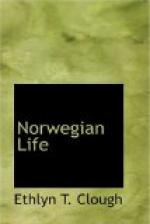Bjoernstjerne Bjoernson (born in Osterdalen, in 1832) is the more popular of the two giants of Norwegian literature of to-day. His works are more national in tone. It has been said that to mention his name is to raise the Norwegian flag. His first successes were made in the field of the novel, and the first two, Synnoeve Solbakken, 1857, and Arne, 1858, made his name famous. These, and his other peasant stories, will always retain their popularity. He soon, however, entered the dramatic field, and has since published a great number of dramas and novels.
In the field of belles-lettres there is at the present time a number of other talented authors. Jonas Lie (born 1833) has produced a number of excellent novels. Then there are Alexander Kielland (born 1849) Magdalene Thoresen (born 1819), Arne Garborg, Gunnar Heiberg, and a number of young authors.
In the field of science, also, modern Norway has a rich literature, with many prominent names, such as the historian Peter Andreas Munch (1810-1864), Johan Ernst Sars (born 1835), and O.A. Oeverland.[e]
CHAPTER VI
THE LITERATURE OF SWEDEN
Swedish literature is sublime and magnificent, like its history and its scenery; it is simple and glad, as well as sad, like the lives of its people. One of the great days in Sweden, or at least in Stockholm, is the celebration, on the 26th of July, of the anniversary of the birth, more than a century and a half ago, of the national poet Bellman.
His songs are as household words throughout the land. To the Stockholm born they speak of their daily life and surroundings, of the green isles and shady banks of the Malar, the flowery woods of Haga, the smiling park of Dijurgarden. Burlesque scenes of the life of the people, street tragedies, drinking bouts, and country junketings; broad humor and Nature’s philosophy; lively fancies and exquisite landscape painting—such are the themes of his song, which from one generation to another has held the heart of the people spellbound. Every man, woman, and child knows his favorite ditties by heart, has sung or hummed them in moments of joy or sorrow. For his song is both joyful and sad. His joy is the joy of the simple hearted, his gladness a Dionysian gladness, the very enjoyment of existence; his sadness that of sympathy with suffering humanity, of anguish at the evanescence of life and happiness. His fancy oscillates between constant extremes and ever-recurring contrasts. It makes of his song, as Tegner has so aptly defined it, “a sorrow decked in roses.” Bright, gay, enraptured, full of sunshine and glamour, like the summer day around Stockholm, it is traversed by a strain of melancholy like a smile through tears, the laugh which conceals a sob. There is symbolism and there is parody in his rustic figures, but they are so living, so real, they appeal so strongly to the innermost feelings, that they seem the embodiment of one’s thoughts. His pictures are like those of the Dutch painters: every trait in the rustic scene tells the life-story of some humble existence.




